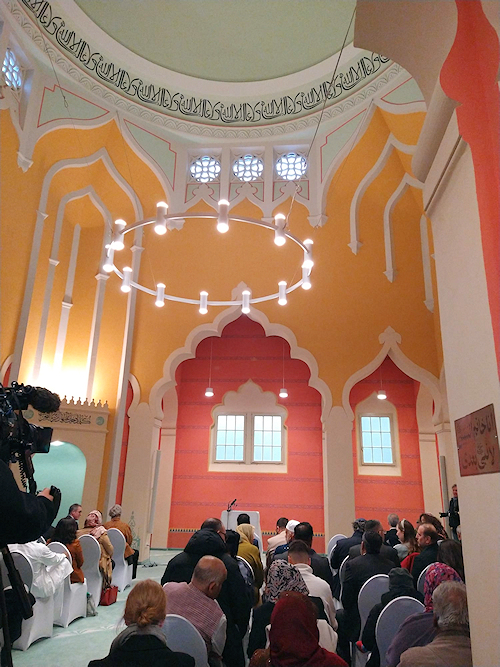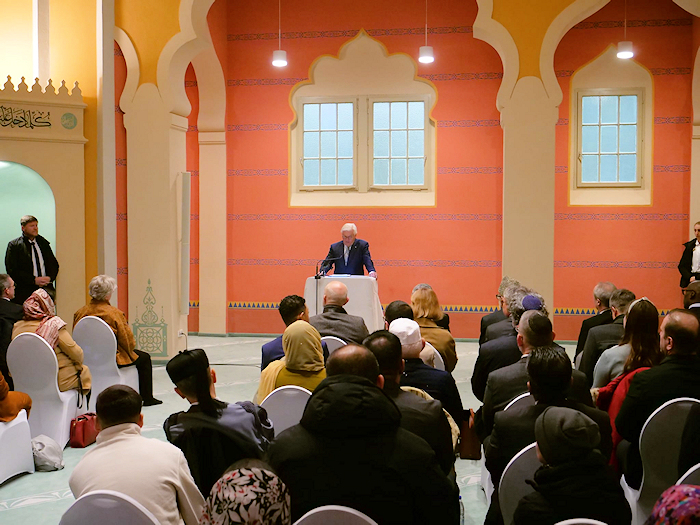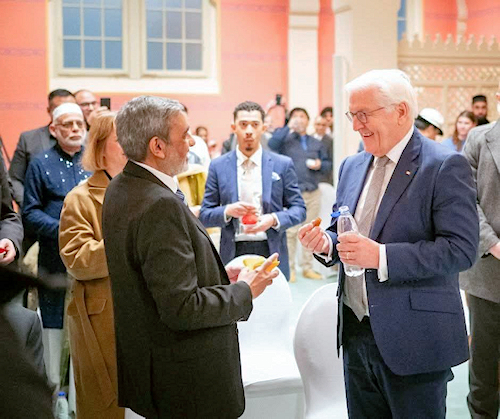Visit of President of Germany, Frank-Walter Steinmeier,
to the Berlin Mosque on 12 March 2025
at fast breaking time (Iftar)
On 12 March 2025, which coincided with 12th Ramadan, the President of Germany, Frank-Walter Steinmeier, visited the Berlin Mosque at fast-breaking time. Before the fast ending he delivered a speech inside the Mosque to a large gathering which had entirely filled the building. The news media and photographers were also present in the Mosque. His speech was followed by a speech by Dr Gerdien Jonker, historian of religion, researcher and author of several publications on the history of Muslims in Germany and the Berlin Mosque. The Imam of the Mosque, Mr Amir Aziz, also spoke, and Dr A.K. Saeed, the world-wide Head of the Lahore Ahmadiyya, concluded by thanking the President.
The fast was then ended inside the Mosque with dates and water, and the Call to Prayer was delivered. Then the President and the gathering proceeded to a marquee set up in the Mosque grounds for dinner.
At this external YouTube link, the speech of the President with English subtitles can be viewed.
Videos
Each of the following videos opens in a new window.
Photographs
↓ Gathering waiting in the Mosque for the President's arrival ↓

↓ The President delivering his speech inside the Mosque ↓

↓ The President (right) with Imam Amir Aziz (left) as the fast breaks inside the Mosque ↓

↓ Dr A.K. Saeed (left), President (centre), and Imam Amir Aziz (right) ↓

At dinner

Reports in the media
1. The Pinnacle Gazette published the following item on 13 March. (See link)
President Steinmeier Visits Historic Mosque For Ramadan Iftar
The visit symbolizes unity and interfaith dialogue during Ramadan celebrations
German President Frank-Walter Steinmeier visited the historic Lahore Ahmadiyya Mosque located in the Wilmersdorf district of Berlin on March 13, 2025. His visit coincided with the holy month of Ramadan, and he participated in the traditional Iftar meal with community members at the mosque.
This mosque, which celebrated its centennial this year, is not just any mosque; it is the oldest mosque in Germany, established between 1924 and 1928 by the Ahmadiyya movement, also known as the Lahore community, headquartered in Pakistan. The mosque's architectural design was created by German architect Karl-Alfred Herrmann, who drew inspiration from the rich patterns of eastern architectural styles.
Since its founding, the Lahore Ahmadiyya Mosque has served as a welcoming space for Muslims from diverse backgrounds. It has become renowned for fostering interfaith dialogue, hosting various events and activities aimed at bringing together individuals from different beliefs and traditions. The mosque itself has enjoyed protected monument status since 1993, indicating its cultural significance, and has held regular Friday prayers since 2010.
During the Iftar, President Steinmeier expressed his happiness at being present and stated, "I am pleased to be here today at this mosque, where people of different beliefs gather for a shared iftar meal." His words highlight the essence of the gathering, reinforcing the idea of unity among various faiths during Ramadan.
Emphasizing the mosque's role, Steinmeier noted, "The mosque's history reflects the spirit of tolerance and openness." This statement succinctly captures the mosque's commitment to being more than just a place of worship. It functions as a center for serious dialogue between Muslims and non-Muslims, showcasing how such interactions can lead to greater mutual respect and coexistence.
Reflecting on the historical backdrop during which the mosque was founded, Steinmeier remarked on the period of significant upheaval after World War I. He pointed out how various religions, including Islam, needed to reevaluate their foundations and seek fresh avenues for communication and greater understandings. This historical perspective adds depth to the mosque's significance as it navigated through contrasting societal challenges.
The architectural elements of the mosque were also highlighted. Steinmeier praised its unique design, which remains one of the outstanding landmarks of Berlin. Consequently, he stated, "The inclusion of all Islamic influences under one roof reflects the spirit of tolerance." This admiration not only recognizes the mosque's aesthetic value but also its symbolic function as a space where diverse Islamic traditions coalesce.
Throughout its 100-year history, the Lahore Ahmadiyya Mosque has embraced individuals from all walks of life, serving as more than just sacred ground but also as a bastion of intercultural harmony and cohabitation. It was built with the intention of bridging communities through shared religious experiences and heartfelt discussions.
Steinmeier's visit and the Iftar meal at the mosque serve as reminders of the significance of such spaces, especially during times of division and misunderstanding. It showcases the importance of open dialogue and community gathering as foundational aspects of society's progress.
The event exemplifies how the mosque continues to uphold its founding principles, which focused on promoting peace, respect, and unity. It stands as a testimony to the Ahmadiyya movement's vision of fostering interfaith relationships and supporting the discourse on tolerance and acceptance, which is particularly pertinent as societies around the world grapple with increasing polarization.
President Steinmeier's presence at the Lahore Ahmadiyya Mosque doesn't only reinforce the mosque's mission but also showcases the role of political figures in supporting cultural and interfaith initiatives. Such acts can inspire others to join similar endeavors, paving the way for more inclusive environments where diversity is celebrated rather than diminished.
With Steinmeier's remarks and commitment to dialogue, the visit solidifies the mosque's position as not merely historic but also as vibrant and dynamic, continuing to play a significant role within the broader Berlin community and beyond. It encourages people of varying backgrounds to engage with one another, cultivating stronger, lasting relationships rooted firmly in respect and shared human values.
2. From Tagesschau. (See link)
Älteste Moschee Deutschlands: Steinmeier besucht "Wilmersdorfer Moschee" zum Fastenbrechen
Bundespräsident Frank-Walter Steinmeier wird der Lahore-Ahmadiyya-Moschee im Berliner Stadtteil Wilmersdorf am Mittwochabend einen Besuch abstatten. Das Staatsoberhaupt will am traditionellen Fastenbrechen im Ramadan teilnehmen. Das Gotteshaus gilt als Deutschlands älteste noch erhaltene Moschee und feiert dieses Jahr ihr hundertjähriges Bestehen.
Einweihung der Kuppel vor hundert Jahren
Die Moschee wurde 1924 bis 1928 von der islamischen Lahore-Ahmadiyya-Bewegung, die ihren Sitz in Pakistan hat, gebaut. Sie wird auch "Wilmersdorfer Moschee" genannt. Der Berliner Architekt Karl Alfred Herrmann entwarf den Bau im "Mogulstil", der sich an orientalische Vorbilder anlehnt. Im April 1925, vor hundert Jahren, wurde die Kuppel eingeweiht.Das Haus stand nach eigenen Angaben von Beginn an Muslimen aller Nationen offen und wurde schnell zu einem Ort des interreligiösen Dialogs. Neben dem Gebet werden dort auch Feste, Vorträge und Veranstaltungen für unterschiedliche Gruppen organisiert. Seit 1993 steht das Gotteshaus unter Denkmalschutz.
English translation:
Oldest mosque in Germany: Steinmeier visits "Wilmersdorf Mosque" to break fast.
Federal President Frank-Walter Steinmeier will visit the Lahore-Ahmadiyya Mosque in Berlin's Wilmersdorf district on Wednesday evening. The head of state wants to participate in the traditional breaking of fasting in Ramadan. The church is considered to be Germany's oldest surviving mosque and is celebrating its centenary this year.
Inauguration of the dome a hundred years ago
The mosque was built from 1924 to 1928 by the Islamic Lahore-Ahmadiyya movement, which is based in Pakistan. It is also called "Wilmersdorf Mosque". The Berlin architect Karl Alfred Herrmann designed the building in the "Mogulstil", which is based on oriental models. In April 1925, a hundred years ago, the dome was inaugurated.
According to its own information, the house was open to Muslims of all nations from the very beginning and quickly became a place of interreligious dialogue. In addition to prayer, festivals, lectures and events for various groups are also organized there. The church has been listed as a historic monument since 1993.
3. Urdu Pakistan newspaper Jang. (See link)
A brief report with a video was published in its issue of 18 March 2025 entitled:
Translation: President of Germany joins Muslims in Iftar at the historic Mosque in Berlin
|